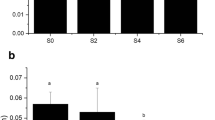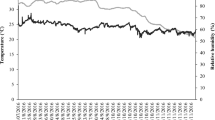Abstract
The ability of superabsorbent polymers (SAP) in drying maize and controlling aflatoxin contamination was studied under different temperatures, drying times and SAP-to-maize ratios. Temperature and drying time showed significant influence on the aflatoxin formation. SAP-to-maize ratios between 1:1 and 1:5 showed little or no aflatoxin contamination after drying to the optimal moisture content (MC) of 13 %, while for ratios 1:10 and 1:20, aflatoxin contamination was not well controlled due to the overall higher MC and drying time, which made these ratios unsuitable for the drying process. Results clearly show that temperature, frequency of SAP change, drying time and SAP-to-maize ratio influenced the drying rate and aflatoxin contamination. Furthermore, it was shown that SAP had good potential for grain drying and can be used iteratively, which can make this system an optimal solution to reduce aflatoxin contamination in maize, particular for developing countries and resource-lacking areas.





Similar content being viewed by others
References
Andrade RD, Lemus R, Perez CE (2011) Models of sorption isotherms for food: uses and limitations. Vitae 18:325–334
Azziz-Baumgartner E, Lindblade K, Gieseker K, Schurz Rogers H, Kieszak S, Njapau H, Schleicher R, Mccoy LF (2005) Case-control study of an acute aflatoxicosis outbreak, Kenya. Environ Health Perspect 113:1779–1783
Brzonkalik K, Herrling T, Syldatk C, Neumann A (2011) Process development for the elucidation of mycotoxin formation in Alternaria alternate. AMB Express 1:1–27
Chayjan RA, Esna-Ashari M (2010) Modeling of heat and entropy sorption of maize (cv. Sc704): neural network method. Res Agric Eng 56:69–76
Daniel IO, Oyekale KO, Ajala MO, Sanni LO, Okelana MO (2009) Physiological quality of hybrid maize seeds during containerized-dry storage with silica gel. Afr J Biotechnol 8:181–186
Delgado JMPQ, Vázquez da Silva M, Nasser RO, Gonçalves MP, Andrade CT (2009) Water sorption isotherms and textural properties of biodegradable starch-based super-absorbent polymers. Defect Diffus Forum 283–286:565–570
Dwivedi LK, Singh DD (2011) Aflatoxins: biosynthesis and methods of biological control. Int J Pharm Biol Sci 2:6275–6299
Ekebafel LO, Ogbeifun DE, Okieimen FE (2011) Effect of native cassava starch-poly (sodium acrylate-co-acrylamide) hydrogel on the growth performance of maize (Zea mays) seedlings. Am J Polym Sci 1:6–11
Foo KY, Hameed BH (2010) Insights into modeling of adsorption isotherm systems. Chem Eng J 156:2–10
Hassan AA, Aziz NH (1998) Influence of moisture content and storage temperature on the production of aflatoxin by Aspergillus flavus EA-81 in maize after exposure to gamma radiation. J Food Saf 18:159–171
Hettiarachchi GHCM, Gooneratne J, Hirimburegama WK (2001) Effect of initial moisture content and relative humidity on the accumulation of aflatoxin in maize grains (Zea Mays) during storage. J Natl Sci Found Sri Lanka 29:29–34
Knipstein B, Huang J, Barr E, Sossenheimer P, Dietzen D, Egner PA, Groopman JD, Rudnick DA (2015) Dietary aflatoxin-induced stunting in a novel rat model: evidence for toxin-induced liver injury and hepatic growth hormone resistance. Pediatr Res 78:120–127
Kunusoth K, Dahal P, Van Asbrouck JV, Bradford KJ (2012) New technology for postharvest drying and storage of seeds. Seed Times (New Delhi) 5:33–38
Kuruwita-Mudiyanselage TD (2008) Smart polymer materials. Ph.D. Thesis, Graduate College, Bowling Green State University, Ohio, USA
Labuza TP, McNally L, Gallagher D, Hawkes J, Hurtado F (1972) Stability of intermediate moisture foods. J Food Sci 37:154–159
Magan N, Aldred D (2007) Post-harvest control strategies: minimizing mycotoxins in the food chain. Int J Food Microbiol 119:131–139
Mrema GC, Gumbe LO, Chepete HJ, Agullo JO (2011) Rural structures in the tropics: design and development. ISBN 978-92-5-107047-5
Muthomi JW, Njenga LN, Gathumbi JK, Chemining’wa GN (2009) The occurrence of aflatoxins in maize and distribution of mycotoxin-producing fungi in Eastern Kenya. Plant Pathol J 8:113–119
Muthomi JW, Mureithi BK, Chemining’wa GN, Gathumbi JK, Mutitu EW (2012) Aspergillus species and Aflatoxin B1 in soil, maize grain and flour samples from semi-arid and humid regions of Kenya. Int J Agric Sci 2:22–34
Okoth SA, Kola MA (2012) Market samples as a source of chronic aflatoxin exposure in Kenya. Afr J Health Sci 20:56–61
Omidian H, Hashemi SA, Sammes PG, Meldrum I (1998) A model for the swelling of superabsorbent polymers. Polymer 39:6697–6704
Rahmani A, Jinap S, Soleimany F (2010) Validation of the procedure for the simultaneous determination of aflatoxins ochratoxin A and zearalenone in cereals using HPLC-FLD. Food Addit Contam A 27:1683–1693
Schaffner DW, Ross WH, Montville TJ (1998) Analysis of the influence of environmental parameters on clostridium botulinum time-to-toxicity using three modeling approaches. Appl Environ Microbiol 64:4416–4422
Shephard GS (2008) Risk assessment of aflatoxins in food in Africa. Food Addit Contam A 25:1246–1256
Sturton SL, Bilanski WK, Menzies DR (1983) Moisture exchange between corn and the dessicant in an intimate mixture. Can Agric Eng 25:139–141
Thoruwa TFN, Johnstone CM, Grant AD, Smith J (2000) Low cost CaCl2 based desiccants for solar crop drying applications. Renew Energy 19:513–520
Troller JA (1991) Trends in research related to the influence of ‘water activity’ on microorganisms in food. Adv Exp Med Biol 302:305–313
Wagacha JM, Muthomi JW (2008) Mycotoxin problem in Africa: current status, implications to food safety and health and possible management strategies. Int J Food Microbiol 124:1–12
Wagacha JM, Mutegi CK, Christie ME, Karanja LW, Kimani J (2013) Changes in fungal population and aflatoxin levels and assessment of major aflatoxin types in stored peanuts (Arachishypogaea Linnaeus). J Food Res 2:10–23
Wicklow DT (1994) Preharvest origins of toxigenic fungi in stored grain. In: Proceedings of the 6th international working conference on stored-product protection
Womack ED, Brownab AE, Sparksa DL (2014) A recent review of non-biological remediation of aflatoxin-contaminated crops. J Sci Food Agric 94:1706–1714
Wu F (2014) Time to face the fungal threat. Nature 516:S7
Wu F, Groopman JD, Pestka JJ (2014) Public health impacts of foodborne mycotoxins. Annu Rev Food Sci Technol 5:351–372
Acknowledgments
The authors are grateful to the ETH Zurich Research Fellowship Partnership Programme (RFPP). Dr. Emil Engelund Thybring and Prof. Ingo Burgert are gratefully acknowledged for assistance with DVS measurements, and for providing access to DVS facilities, respectively.
Author information
Authors and Affiliations
Corresponding authors
Additional information
Duncan O. Mbuge and Renata Negrini have contributed equally to this work.
Electronic supplementary material
Below is the link to the electronic supplementary material.
Rights and permissions
About this article
Cite this article
Mbuge, D.O., Negrini, R., Nyakundi, L.O. et al. Application of superabsorbent polymers (SAP) as desiccants to dry maize and reduce aflatoxin contamination. J Food Sci Technol 53, 3157–3165 (2016). https://doi.org/10.1007/s13197-016-2289-6
Revised:
Accepted:
Published:
Issue Date:
DOI: https://doi.org/10.1007/s13197-016-2289-6




